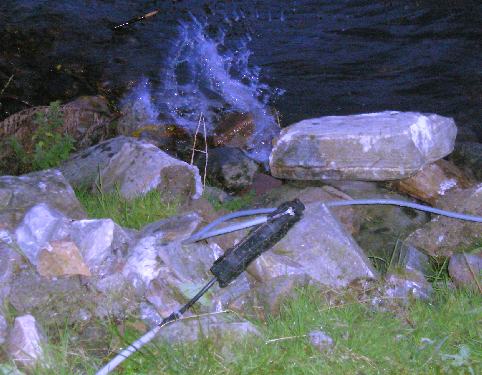In mid
2005 the we received flyers from BT telling us that broadband was
available from BT. Some of us assumed that BT had installed
new
technology that would make broadband possible. But the flyer was a
lie, as anyone who inquired about the availability of
broadband found
out. BT had simply not bothered to check which areas
surrounding the Glenelg exchange could actually receive broadband.
The author, who like many, was upset by this wrote to his MP,
Charles Kennedy, who passed the letter on to SMP Tavish Scott ("Our
commitment is to ensure every community in Scotland will have access to
broadband by the end of this year [2005]".) who consulted BT.
The only help that Mr Scott gave was to stress the importance
of registering interest with the Highlands and Islands Enterprise (HIE)
website. Mr. Kennedy wrote back admitting that
the answers from BT and Mr. Scott were "unsatisfactory", but offered no
further help.
At
least 20 of us have registered at the HIE website, some us
have done so repeatedly. Many of us have checked the box that
asks HIE to send you information about developments, but no-one has
received anything from HIE.
The author also wrote to the head of BT Scotland,
Mr. Brendan Dick, and talked to Mr. Stuart Robinson of HIE.
Both confirmed that there are no current plans to provide
broadband
to Arnisdale.
Why
don't we have broadband?
Much
of the following is conjecture. It is difficult
to get
information about what BT has done and their current policies.
We
don't have broadband because the £16.5 million
that the Scottish
Executive gave BT has now been "spent", and there is no money left to
provide Arnidsale with broadband. Moreover it's not
clear how
BT
would provide broadband to Arnisdale if it wanted to do this.
What BT has done is to upgrade existing exchanges that might
have
proved uneconomical to upgrade otherwise. They have not, as
claimed in one of their media
blurbs
achieved a "major engineering task". They may have upgraded
the
existing infrastructure, and they have installed standard broadband
interfaces in existing exchanges.
Although
BT must be able to form an estimate of how many people in the
Highlands are in the same situation as people in Arnisdale, they will
not divulge this information, for the mind-boggling reason, according
to Mr. Robinson, that the information has "commercial value".
If
BT cannot find an economical method of bringing broadband to remote
communities, shouldn't they allow other organisations to try?
So
we have no idea what priority Arnisdale will be given if there is
further funding.
There
is a rumour to the effect that the demand for telephone lines in
Arnisdale and Corran is about to exceed the capacity of the current
cable. A frightening prospect is that BT will solve this
problem
simply by running a second cable along the road to Glenelg.
Apparently BT separates its obligation to provide telephone
connections from its commercial interest in providing broadband.
An optic fibre to Glenelg or wireless link to Skye would
solve both problems
and would surely, in the long-term, prove more economical.
The
Mason report and further funding
[30 Dec 2006] Scottish
Executive has just announced
a further £5 million to deliver broadband to the "remaining
clusters". There is also a Mason
report,
commissioned by Scottish Executive, to investigate Broadband
availability in Scotland. The report is much more
informative than anything yet published by the Scottish Executive or
British Telecom. In particular it attempts to identify "clusters" --
small communities that do not yet have broadband.
The
bad news is that Arnisdale, while it surely qualifies as such a
cluster on the basis of
both population and demand for broadband, was not in Scottish
Executive's database; nor was it identified by Mason's mapping
software. Arnisdale gets a short comment in an end-note, and
the reason for the lack of broadband is given as a "local BT
cabling problem"! While not exactly a lie, the statement is
about as misleading as it could be. It indicates that a
local fix, not a substantial change to our communications
infrastructure is required. A bureaucrat who is trying to
assign priorities is unlikely to put Arnisdale high on the list.
Does
Scottish Executive know about us?
[14 Jan 2007] After
sending news of the Mason report to the community and to Stuart
Robertson, Mr. Harry Emambocus of the Scottish Executive wrote to
"reassure you that whilst the cluster in Glenelg/Arnisdale area is not
mentioned in detail in the Mason report on Broadband reach, it is one
which is known to the Executive, and is on our database of broadband
access problems". The correspondence with Mr. Emambocus
is far from reassuring. The only information he provided was
the
list of potential broadband users we had sent to Stuart Robertson.
He seems to know nothing of the business activities in
Arnisdale,
and he will not, for reasons -- he claims -- of confidentiality,
divulge the costs
of providing us with broadband. Does Scottish Executive have
anything like adequate information on which to priortise its
expenditure on broadband? Read the correspondence and form
your own opinion.
Business as
usual from BT
[14 Jan 2007] Meanwhile,
BT continues to live "up" to its reputation. Some of
us have been solicited from
people claiming to be BT employees in
India, asking us to sign up for broadband. We also have reason to
believe that BT is
intending to continue to use 100-year old technology
to provide our communications with the rest of the world.
Peter Buneman
The Schoolhouse
Arnisdale, IV40 8JL
Email:

Previous update: 14 January 2007
Last update: 2 June 2008
Please note that access to this web page is provided by the University
of Pennsylvania as a courtesy to the author. It should be
obvious that the opinions expressed on this page are entirely those of
the author and are in no way condoned by the University of Pennsylvania.


